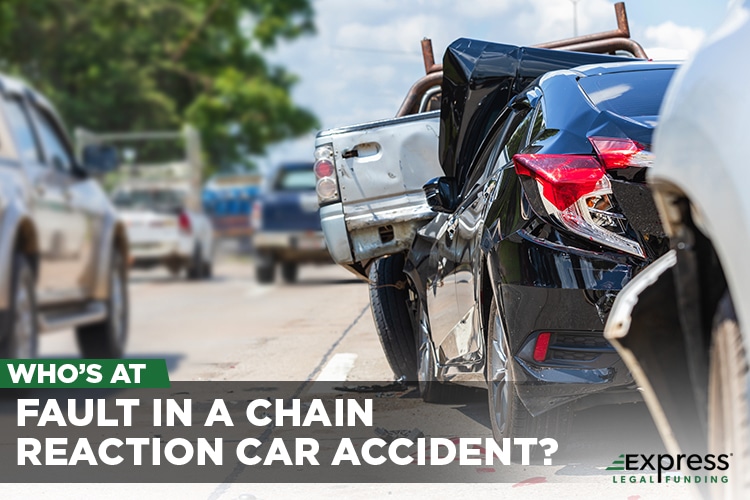
Motor vehicle accidents occur every day. They are common due to environmental factors, negligence, or even simple acts of fate. Sometimes they are simple fender benders with no injury, and other times they are catastrophic and can result in fatalities. In the most extreme cases, multiple vehicles are involved in the accident to the point it can be challenging to ascertain who was responsible for the occurrence.
Chain reaction car accidents are an all-too-common occurrence with an all-too-common issue of being unable to determine who is the liable party for the initial collision. Unfortunately, this same confusion about who is responsible for the incident can also impact your ability to successfully file a personal injury claim against that driver.
We hope to shed some light on how to determine who is at fault for your injury following a chain reaction accident involving motor vehicles.
Let’s get started!
What is a Chain Reaction Car Accident?
A chain-reaction car accident is undoubtedly more complicated than a traditional motor vehicle accident, but understanding the basic concept is reasonably straightforward. A chain reaction accident is any collision of multiple vehicles in which one vehicle caused the initial collision, which caused secondary chain-reaction crashes, and so forth.
In essence, a chain reaction accident will involve at least three different vehicles involved in a series of cascading collisions. The concept itself is pretty evident in the name of the type of accident.
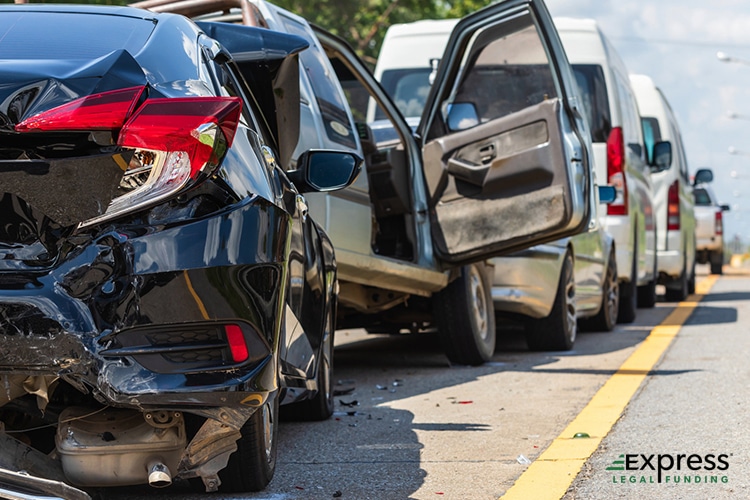
Envision, if you would, two vehicles. The first is stopped at a red light, and the second is driving not too far behind the first vehicle. We will call these Vehicle A and Vehicle B.
Say that Vehicle B’s driver fails to notice the red light and speeds directly into Vehicle A and rear-ends it. The impact shakes Vehicle A’s driver and causes Vehicle A to release its brake just as the traffic flow of the adjacent lane resumes, and a third vehicle, Vehicle C, strikes Vehicle A from the side. The infographic below demonstrates what this type of car accident would look like from above.

That, in all simplicity, is an example of a chain reaction accident. By this logic, a chain reaction accident can consist of three vehicles or 15 so long as it all stems from one originating collision. Some colossal chain reaction collisions can involve as many as 200 cars. These massive rear-end collisions typically only occur under severe weather conditions like icy roads or heavy fog.
The fact that several vehicles are involved in chain-reaction collisions means that more people are injured. In addition, the severity of the accident will often depend on how fast the striking cars were traveling, which might lead to even more collisions. That initial collision serves as “ground zero” of the entire accident, but the question of “fault” remains.
What is “Fault” in a Chain Reaction Crash?
“Fault” is an oft-abused term that has diluted its legal meaning to an inappropriate degree. The idea of “fault” has boiled down to juvenile finger-pointing from playground antics that make the legal version of the concept seem trivial. However, proving fault in a motor vehicle accident is far more complicated and frustrating than you might otherwise have assumed.
To determine fault in a personal injury case of any kind, one needs to prove that their actions or negligence at least partially resulted in the accident occurring. Most states have various forms of this comparative negligence.
Insurance companies often try to maintain that their insured driver is only fractionally at fault, which makes recovering money on personal injuries more complicated. Another factor to keep in mind is the insurance policy limits of the at fault drivers are often too low to fairly compensate the many injured victims of a chain reaction accident.
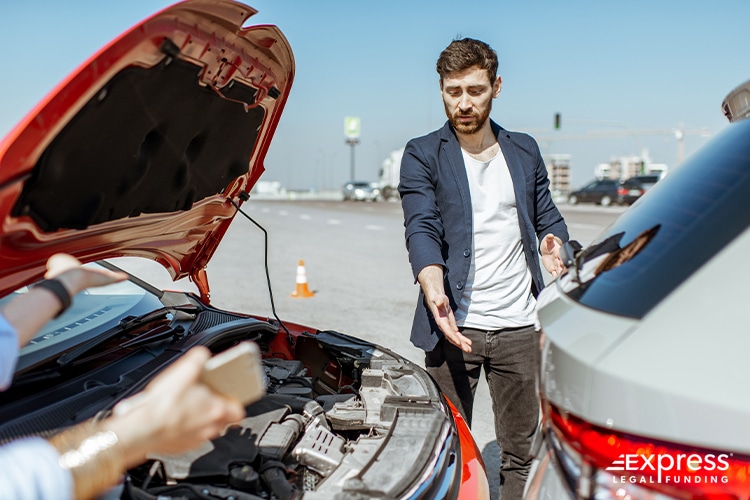
Proving fault requires evidence to corroborate your account of events that would put someone else’s actions as the cause of the incident. For example, when it comes to motor vehicle accidents, one driver must have been doing something unsafe that resulted in the initial collision.
This danger could range from texting while driving, being intoxicated, or simply disregarding road laws such as speed limits or traffic lights. These actions could reasonably be presented as the negligence needed to prove a specific driver was primarily at fault for a collision.
Being assessed by the insurance companies for being equally at fault with another driver can disqualify you from seeking remuneration since your failure to cooperate with the laws of the road contributed to the accident. Conversely, the insurance companies and car accident lawyers can find that the accident is your fault if you were the motorist committing these violations.
Those same personal injury lawyers could also blame both parties if you were both negligent in the first place. Ultimately, it boils down to finding the evidence that supports your version of events and proves you were not negligent yourself.
Finding the evidence needed is generally accomplished by the officers responding to the collision. They assess the situation and interview the other drivers and passengers involved. Your argument that you were entirely not at fault becomes stronger with more evidence that corroborates your version of events. Other drivers telling the police their version of how it happened can also help.
Interested parties can gather further evidence from mobile devices that happened to be recording at the time of the accident and by documenting the damage done to your vehicle. Just remember that in multi-vehicle accidents, multiple people can be found at varying degrees at fault for the same incident.
Who is at Fault in a Chain Reaction Accident?
Now that we know what a chain-reaction accident is, the common causes, and how fault works, the big question of who is at fault in chain-reaction accidents remains. This point is where accidents of this nature become more complex compared to two-vehicle collisions. Since a chain reaction accident requires a minimum of three vehicles to be considered, fault can be divvied up in ways that exceed the norm.
The basic rule of thumb is that the first driver who caused the first collision that led to all subsequent crashes is generally the at-fault party. However, this is not always the case.
Let us begin by analyzing a hypothetical three-car collision using our previous example of Drivers A and C being stopped at lights when Driver B comes barreling down the road. Just as the light turns green for Driver C, Driver B strikes Driver A’s vehicle and forces them into the now oncoming traffic, causing a secondary collision between Drivers A and C.
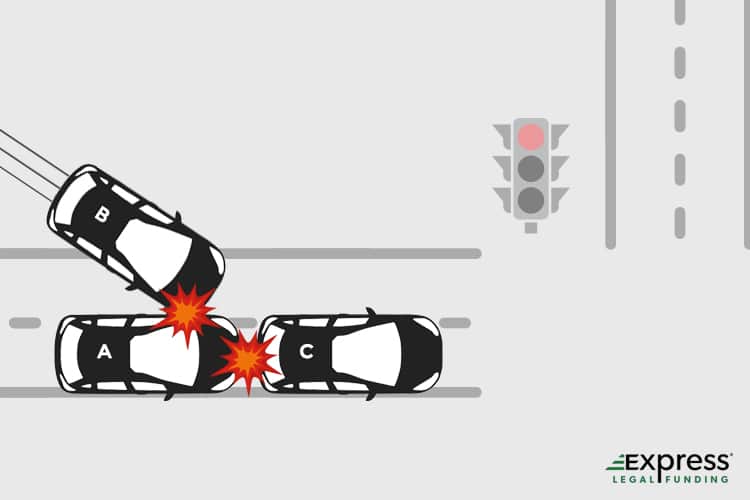
In this circumstance, Drivers A and C abided by the road’s laws until Driver B came along and struck Driver A, forcing them into traffic. In this instance, Driver B is at fault due to their negligence, causing both the initial and secondary collision. In this circumstance, Drivers A and C would seek legal action against Driver B for their serious injuries and vehicle damage.
This situation is a more clean-cut example of a chain reaction accident in which a single driver can be identified as the party at fault. Unfortunately, they are not all that simple.
Again, let us imagine a situation where it’s back to back rear-end collisions. Driver A is stopped at a light. Like last time, Driver B is speeding behind and rapidly approaching where Driver A is stopped. However, this time, Driver C is also driving along behind Driver B and is unable to see that Driver B is about to collide with Driver A. Like last time, Driver B strikes Driver A’s vehicle due to failing to see the red light.
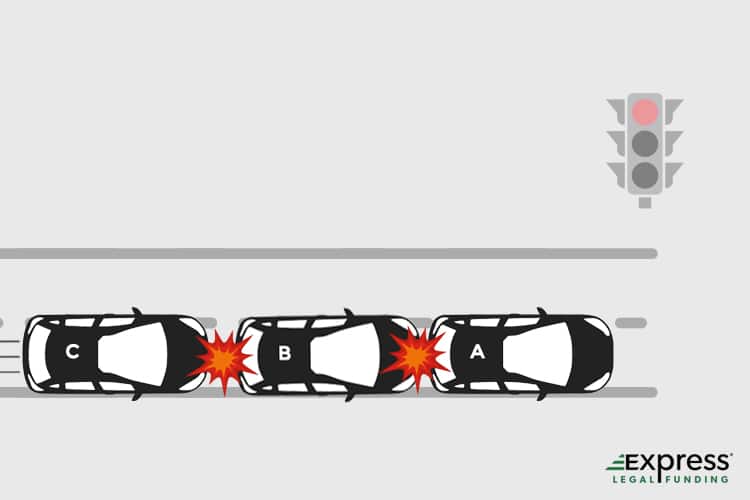
However, since Driver C was following Driver B’s example rather than independently focusing on the flow of traffic and the traffic light, Driver C struck Driver B shortly after Driver B struck Driver A and caused a second collision. This impact causes Driver A to experience the third collision due to the force of Driver B’s vehicle being struck, causing it to jut forward into Driver A again.
This situation is unique because Driver B and Driver C are responsible for the chain reaction accident. While Driver B was responsible for the initial collision, Driver C’s negligence led to another crash. This fault means that Driver A can file claims against drivers B and C for injuries and damage to their vehicle.
This situation would also lead to Drivers B and C working out the damage to Driver B’s vehicle amongst themselves. So it would be a case of B and C being responsible for damage to A and C being liable for damage to B. However, the number of vehicles and parties involved in the auto accident can further complicate these situations.
The more vehicles involved, the harder it becomes to narrow down who caused the initial collision, who was not paying attention to avoid that collision, and the fact that proving a tertiary collision was the result of negligence rather than simply being unable to outmaneuver the accident safely.
There are many other factors, such as the contents of the police report, the location of the vehicle’s property damage, whether there was distracted driving, and even comparative or contributory negligence like faulty brake lights (depending on the state).
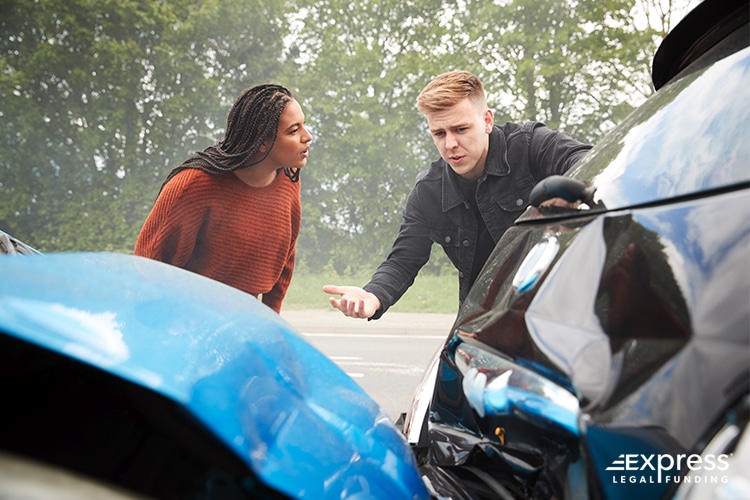
The level of chaos in a chain reaction collision makes it one of the more complex personal injury claims to file. The amount of evidence needed to prove you are not at fault is a challenge to come by with so many conflicting versions of the event or simply being uncooperative with providing essential information. Uncooperative drivers can significantly slow personal injury cases, especially when the at-fault drivers accept no liability for causing the accident.
A multi-car accident is typically the person’s fault responsible for the initial collision; therefore, whether the person who struck the vehicle or the person whose vehicle was struck is irrelevant, depending on who the negligent party allowed the incident to come to pass.
One additional factor may not come into play for a chain reaction accident; if the driver at fault for the initial collision was operating a vehicle for their employer. The claim is filed against the driver rather than the employer in these car accident cases. Even though the negligence was of a professional on company time which caused the accident, this is the case.
Everyone who was a victim of the accident and did not actively contribute to additional collisions would also file a claim against the employed driver. It can make these cases tricky and add an extra layer of commercial accountability. Commercial insurance policies almost always have higher policy limits on the positive side, allowing more compensation money to go around to those hurt in the accident.
Will You Need Representation?
Representing yourself during a personal injury claim is never advisable, even when you know what you are doing. In cases where multiple vehicles are involved, it is even more risky to represent yourself. Legal proceedings are highly complicated in and of themselves. In most cases, personal injury claims are negotiated via a law firm that will represent you against the claims adjuster of the responsible party.
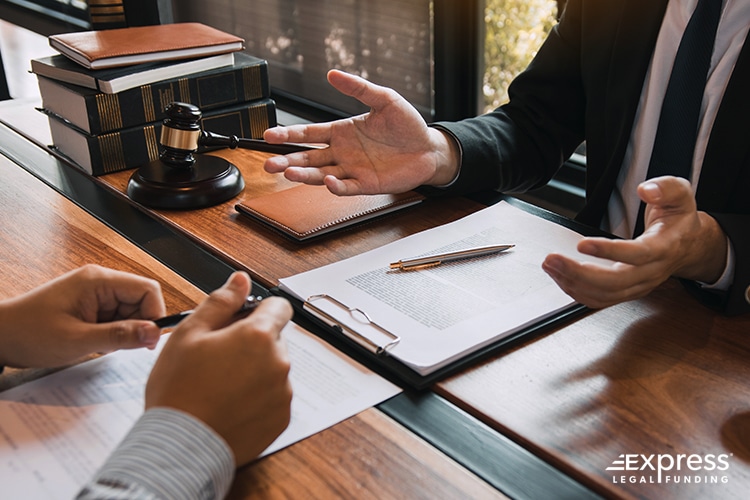
We would never presume to tell you how to go about your case. However, we would be remiss if we actively encouraged you to represent yourself in a complicated personal injury claim involving chained collisions. At the very least, it could never hurt to seek out a car accident attorney’s services when dealing with a personal injury claim, but there is no mandate to do so within the bounds of United States law.
Closing Statements
Chain reaction car accidents are horrific scenes to encounter, whether you are involved or simply standing on the sidelines as they occur. Even long after the collisions, they can be a haunting vision to behold.
Even more disturbing is that finding the epicenter of such a pileup after the fact can be near-impossible unless you were witness to the carnage that ensured following the initial collision.
Furthermore, without understanding what happened at the accident scene, determining who was at fault becomes an arduous task, especially for those looking to recoup their losses after being a victim of one of these massive accidents.
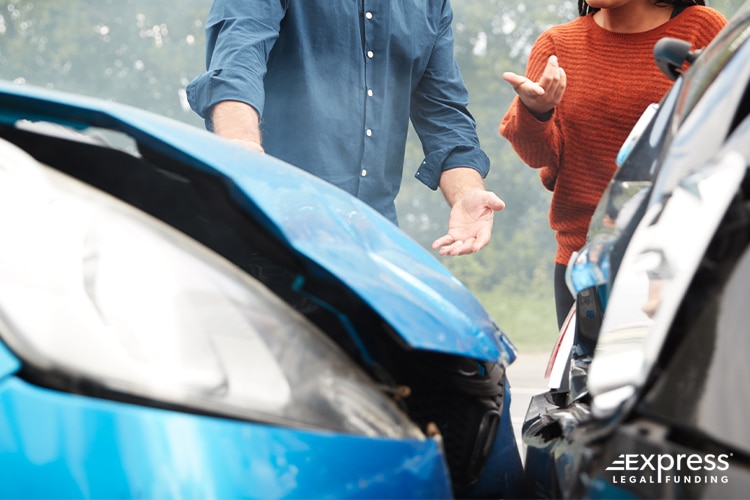
Finding justice following a chain reaction accident can be a challenging, exhausting, and profoundly upsetting endeavor. The stress caused by a car crash is especially hard when you factor in the fact that pursuing a claim is costly as you seek to repair or replace your damaged vehicle and pay for your medical treatment.
These expenses are in addition to your regular finances. You’ll still have to pay for your everyday living costs such as rent/mortgage, food, and utilities. With all of these costs, staying afloat is always more difficult to accomplish. Fortunately, there is a financial solution waiting.
Legal funding can enable you to pay for your essential needs, such as mortgage payments and food, and only needs to be repaid from your settlement or trial award. If you lose your claim in court, you do not need to repay any of it. We at Express Legal Funding can offer such services and are ready to help. Call us today for a free consultation and to learn more about legal funding it can help you.
FAQs: Liability in Chain Reaction Motor Vehicle Accidents
Who is at fault in a multiple rear-end collision?
Determining fault in a multiple rear-end collision, also known as a chain reaction accident, can be complex. It typically involves investigating who caused the initial collision that led to the subsequent crashes. This could be due to actions such as texting while driving, being intoxicated, or disregarding road laws.
However, it’s important to note that more than one driver can be found at fault. If a driver’s negligence contributed to the accident, they may share the blame.
Evidence such as witness statements, traffic camera footage, and police reports are often used to determine fault.
It’s recommended to consult with a car accident lawyer to understand the specifics of your situation.
Who is typically at fault in a chain reaction accident?
In a chain reaction accident, the driver who caused the initial collision is typically considered at fault. However, determining fault can be more complex as other drivers may also share responsibility depending on their actions, such as failing to maintain a safe distance or not reacting appropriately to the situation.
In these cases, fault is decided based on evidence like police reports, vehicle damage, and witness statements to assess each driver’s level of responsibility.
How can legal funding help with chain reaction accident claims?
Legal funding can help individuals involved in chain reaction accidents by providing financial support while they await a settlement. Since these cases often take time to resolve, pre-settlement funding can cover living expenses, medical bills, and other costs that may arise due to injuries or loss of income.
This way, victims can relieve financial stress without rushing to accept a lower settlement offer. The funding does not have to be repaid if the claimant does not recover money from their case, offering a risk-free option for those needing immediate funds during the litigation process.
